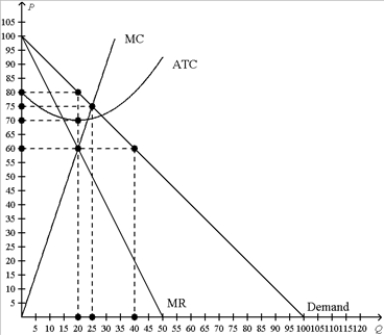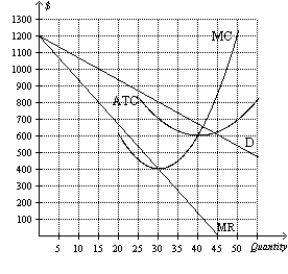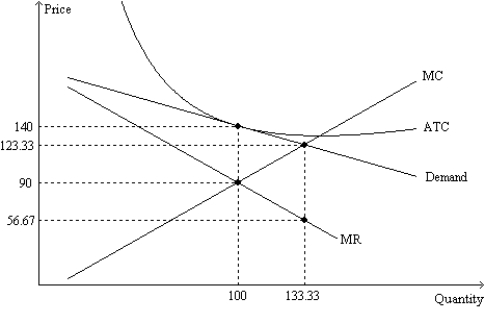A) at 100 units.
B) between 100 and 133.33 units.
C) at 133.33 units.
D) beyond 133.33 units.
F) A) and C)
Correct Answer

verified
Correct Answer
verified
True/False
Monopolistic competition is characterized by a few sellers offering similar products, whereas oligopoly is characterized by many sellers offering differentiated products.
B) False
Correct Answer

verified
Correct Answer
verified
Multiple Choice
A study of the market for optometrists' services in the 1960s showed that
A) all states in the United States prohibited advertising by optometrists.
B) almost all professional optometrists opposed legal restrictions on their rights to advertise.
C) the average price of eyeglasses would decrease if the legal restrictions on advertising by optometrists were removed.
D) advertising on eyeglasses limited competition among optometrists.
F) C) and D)
Correct Answer

verified
Correct Answer
verified
Multiple Choice
In a monopolistically competitive market,
A) entry by new firms is impeded by barriers to entry; thus, the number of firms in the market is never ideal.
B) entry by new firms is impeded by barriers to entry, but the number of firms in the market is nevertheless always ideal.
C) free entry ensures that the number of firms in the market is ideal.
D) there may be too few or too many firms in the market, despite free entry.
F) A) and C)
Correct Answer

verified
Correct Answer
verified
Multiple Choice
In which of the following market structures do firms produce the welfare-maximizing level of output?
A) perfect competition
B) monopolistic competition
C) monopoly
D) Both a and b are correct.
F) A) and C)
Correct Answer

verified
Correct Answer
verified
Multiple Choice
A monopolistically competitive market has characteristics that are similar to
A) a monopoly only.
B) a competitive firm only.
C) both a monopoly and a competitive firm.
D) neither a monopoly nor a competitive firm.
F) A) and C)
Correct Answer

verified
Correct Answer
verified
True/False
One thing that both critics of advertising and defenders of advertising agree on is that advertising fosters competition.
B) False
Correct Answer

verified
Correct Answer
verified
Multiple Choice
Figure 16-3
This figure depicts a situation in a monopolistically competitive market.  -Refer to Figure 16-3. What price will the monopolistically competitive firm charge in this market?
-Refer to Figure 16-3. What price will the monopolistically competitive firm charge in this market?
A) $60
B) $70
C) $75
D) $80
F) B) and C)
Correct Answer

verified
Correct Answer
verified
Multiple Choice
Suppose for some firm that average total cost is minimized at Q1 units of output. For a monopolistically competitive firm in long-run equilibrium, Q1
A) is also the level of output at which marginal cost equals average total cost.
B) exceeds the level of output at which there is a point of tangency between the demand curve and the average total cost curve.
C) exceeds the level of output at which marginal revenue equals marginal cost.
D) All of the above are correct.
F) A) and C)
Correct Answer

verified
Correct Answer
verified
True/False
When McDonald's opens a store in Dhaka, Bangladesh, it has a strong incentive to enforce product quality consistent with stores in the United States.
B) False
Correct Answer

verified
Correct Answer
verified
True/False
To be considered an oligopoly, the market must have a concentration ratio below 50%.
B) False
Correct Answer

verified
Correct Answer
verified
Multiple Choice
A firm produces the welfare-maximizing level of output
A) only when the market is perfectly competitive.
B) only when the market is a monopoly or monopolistically competitive.
C) only when the market is monopolistically competitive or perfectly competitive.
D) when the market is perfectly competitive, monopolistically competitive, or monopolistid.
F) B) and C)
Correct Answer

verified
Correct Answer
verified
Multiple Choice
In some countries, brand name fast-food restaurants are not allowed to operate. Such restrictions are likely to
A) enhance the social welfare of society.
B) increase the number of fast-food restaurants.
C) reduce barriers to entry in imperfect markets.
D) reduce the competitive nature of local fast-food markets.
F) B) and C)
Correct Answer

verified
Correct Answer
verified
Multiple Choice
In perfect competition as well as in monopolistic competition,
A) marginal revenue is equal to price for each firm.
B) profit is positive in a long-run equilibrium for each firm.
C) entry and exit by firms are restricted.
D) there are many firms in a single market.
F) A) and D)
Correct Answer

verified
Correct Answer
verified
Multiple Choice
Figure 16-4  -Refer to Figure 16-4. At the profit-maximizing, or loss-minimizing, output level, the firm in this figure has total costs of approximately
-Refer to Figure 16-4. At the profit-maximizing, or loss-minimizing, output level, the firm in this figure has total costs of approximately
A) $12,000.
B) $18,000.
C) $21,000.
D) $24,000.
F) A) and C)
Correct Answer

verified
Correct Answer
verified
True/False
When a firm operates at efficient scale, it is producing at the minimum point on its average total cost curve.
B) False
Correct Answer

verified
Correct Answer
verified
Multiple Choice
Figure 16-3
This figure depicts a situation in a monopolistically competitive market.  -Refer to Figure 16-3. What is the profit-maximizing price, quantity, and resulting profit?
-Refer to Figure 16-3. What is the profit-maximizing price, quantity, and resulting profit?
A) P=$60, Q=20 units, profit=$200
B) P=$80, Q=20 units, profit=$200
C) P=$75, Q=25 units, profit=$100
D) P=$60, Q=40 units, profit=$0
F) C) and D)
Correct Answer

verified
Correct Answer
verified
Multiple Choice
A law that restricts the ability of hotels/motels to advertise on billboards outside of a resort community would likely lead to
A) no change in profits for all hotels/motels.
B) reduced efficiency of local lodging markets.
C) a request by consumers to increase the number of billboards.
D) increased price competition among hotels/motels in the community.
F) B) and C)
Correct Answer

verified
Correct Answer
verified
Multiple Choice
Figure 16-9
The figure is drawn for a monopolistically-competitive firm.  -Refer to Figure 16-9. For this firm, the long-run equilibrium quantity of output is
-Refer to Figure 16-9. For this firm, the long-run equilibrium quantity of output is
A) 100 and the long-run equilibrium price is $90.
B) 100 and the long-run equilibrium price is $140.
C) 133.33 and the long-run equilibrium price is $56.67.
D) 133.33 and the long-run equilibrium price is $123.33.
F) A) and D)
Correct Answer

verified
Correct Answer
verified
Multiple Choice
A monopolistically competitive industry is characterized by
A) many firms selling products that are similar but not identical.
B) many firms selling identical products.
C) a few firms selling products that are similar but not identical.
D) a few firms selling highly different products.
F) A) and C)
Correct Answer

verified
Correct Answer
verified
Showing 301 - 320 of 587
Related Exams